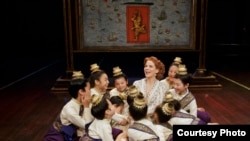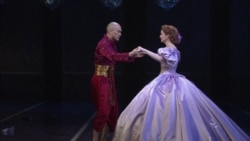Classic stories - novels, plays, movies - are timeless because they have something relevant to say to each generation. That’s true of a new Broadway revival of Rodgers and Hammerstein’s The King and I.
The 21st century version of the show garnered nine Tony award nominations.
Director Bartlett Sher has been familiar with The King and I since he performed it in high school, but it’s only since he’s been working on the revival that he’s dug deep into the actual history behind the show.
The 1950s musical was based on a 1940s biographical novel about an Englishwoman in the court of Siam. In 1862, at the invitation of King Mongkut of Siam, a young woman of English and Indian heritage, Anna Leonowens - the I, in The King and I - went to teach at his court.
“So, for me the sort of incredible pursuit of Anna Leonowens as a woman, in the middle of the 19th century, to go as a school teacher, independent of any country, and teach young women in a developing culture and help them gain education, to find that in 1951, Oscar Hammerstein was somehow attracted to this story is just, frankly, mind-blowing,” Sher said.
Sher, who won a 2008 Tony award directing Rodgers and Hammerstein’s South Pacific, treats the writing duo’s works the same way he treats Shakespeare or Clifford Odets - parsing the script to find contemporary resonances.
He said “Getting to Know You,” one of the most important songs in the show, is not just about the relationship between Anna and the King’s wives and children.
“The pure effort of that, the “getting to know you” quality is so impressive, now in our so deeply divided current country and world, in so many ways,” he said. “Just that small effort of reaching across a culture, to try to help them understand her and her understand them in the simplest ways.”
The 51 members of the cast of The King and I are mostly Asian-American and they had to get to know a world - 19th Century Thailand - which is very foreign to them.
“I think the hardest part for the women - for the very modern Asian women that we have in the show today - looking at how do we share our husband?” said Ruthie Ann Miles, who plays Lady Thiang, one of the king’s many wives. “So, you know, we have had discussions, how we do this with each other and how jealous do we get? What is the internal relationship between these women?"
Siam’s acceptance of polygamy led outsiders to consider the country “barbaric.” The king brought Anna Leonowens to his court, in part, to help dispel that notion and any Western thoughts of colonization. Librettist Oscar Hammerstein was not afraid of addressing political and social issues in his work, as was evident in an interview from the 1950s.
“The King and I was a struggle within the man who was trying to be a liberal and had been born a conservative,” Hammerstein said. “[He] had been born with a conviction that the absolute power of a king should not be questioned, and yet something had given him an interest in Western democracy and this governess who had come here was the champion of that and she really destroyed him, by deepening the doubt about his power."
In the current production, Japanese film star Ken Watanabe plays the Thai king and Broadway star Kelli O’Hara plays Anna. O’Hara said she’s playing the character that Anna Leonowens wanted to be: noble, educated, fair, and strong.
“She made herself up in order to have a job, in order to take care of her children after her husband died,” O’Hara said. “She was of mixed race, she did things that she had to do. And then she wrote books about it and about who she wanted to be. She was a valuable woman, a respectable woman; inspirational. And I love that for her."
For director Sher, the big takeaway from the show is the power of the women.
“The tension we fight with now, between traditional views of culture, traditional views of society and changing, transforming views,” he said. “And as we always learn, women and the role of women, become central to that conversation. And that’s at the center of the piece, whether it’s Lady Thiang or whether it’s Anna Leonowens; they’re all different refractions of what are the possibilities and possible journeys of women within a culture."
And that, he says, is something that’s true today in societies in the Middle East and Asia… and here in the U.S.







